MGT5OBR: Analysis of Organizational Culture & Recommendations
VerifiedAdded on 2023/06/07
|9
|2844
|258
Report
AI Summary
This report provides a comprehensive analysis of organizational culture, drawing insights from three academic articles. It begins by defining organizational culture and summarizing the chosen articles, which include discussions on organizational behavior, the importance of flexible cultures and authentic leadership, and a dynamic model for understanding organizational culture. The analysis delves into Schein's perspective on organizational culture, linking it to technology, people, and employee behavior, and connects it with the organizational behavior concepts presented by Trilok. It further explores the relationship between authentic leadership and flexible organizational cultures, as discussed by Azanza, Moriano, and Molero, emphasizing the positive impact on employee satisfaction. The report concludes with recommendations for leaders and managers, focusing on transparency, employee valuation, and the adoption of flexible leadership styles to foster a motivated and engaged workforce, highlighting the interconnectedness of organizational behavior, culture, and leadership in driving organizational success. Desklib provides a platform to access similar solved assignments and study resources.
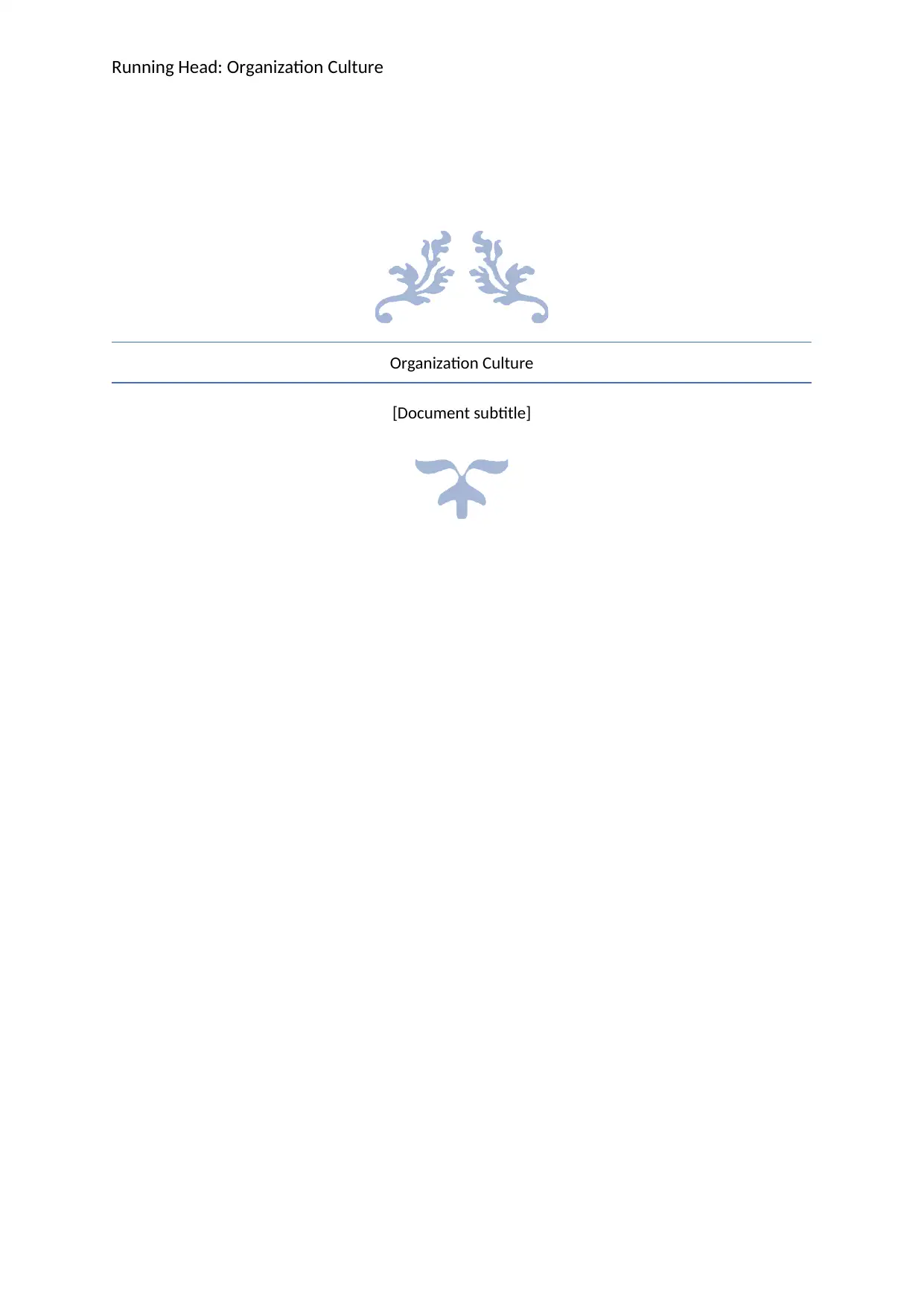
Running Head: Organization Culture
Organization Culture
[Document subtitle]
Organization Culture
[Document subtitle]
Paraphrase This Document
Need a fresh take? Get an instant paraphrase of this document with our AI Paraphraser
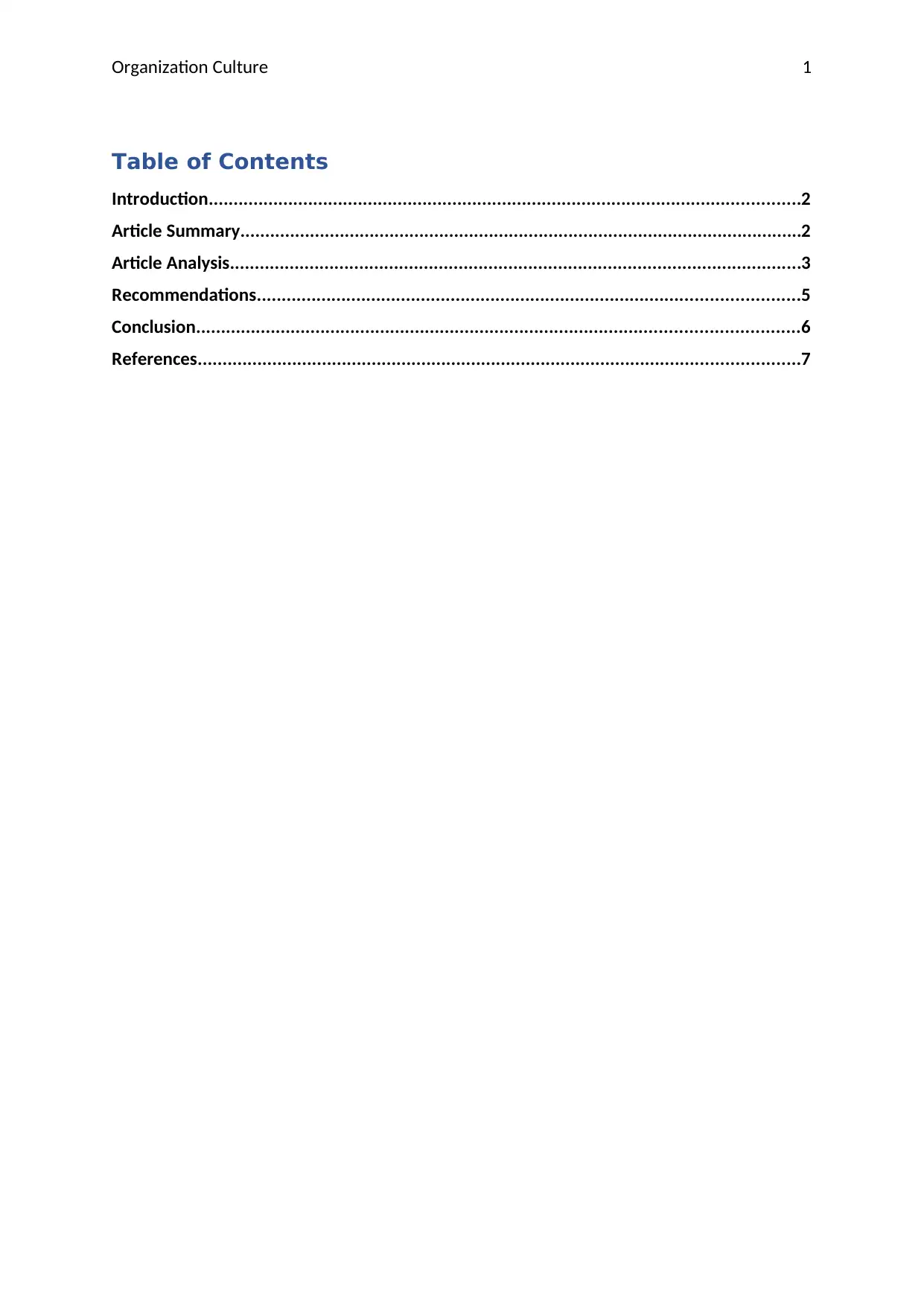
Organization Culture
Table of Contents
Introduction.......................................................................................................................2
Article Summary.................................................................................................................2
Article Analysis...................................................................................................................3
Recommendations.............................................................................................................5
Conclusion.........................................................................................................................6
References.........................................................................................................................7
1
Table of Contents
Introduction.......................................................................................................................2
Article Summary.................................................................................................................2
Article Analysis...................................................................................................................3
Recommendations.............................................................................................................5
Conclusion.........................................................................................................................6
References.........................................................................................................................7
1
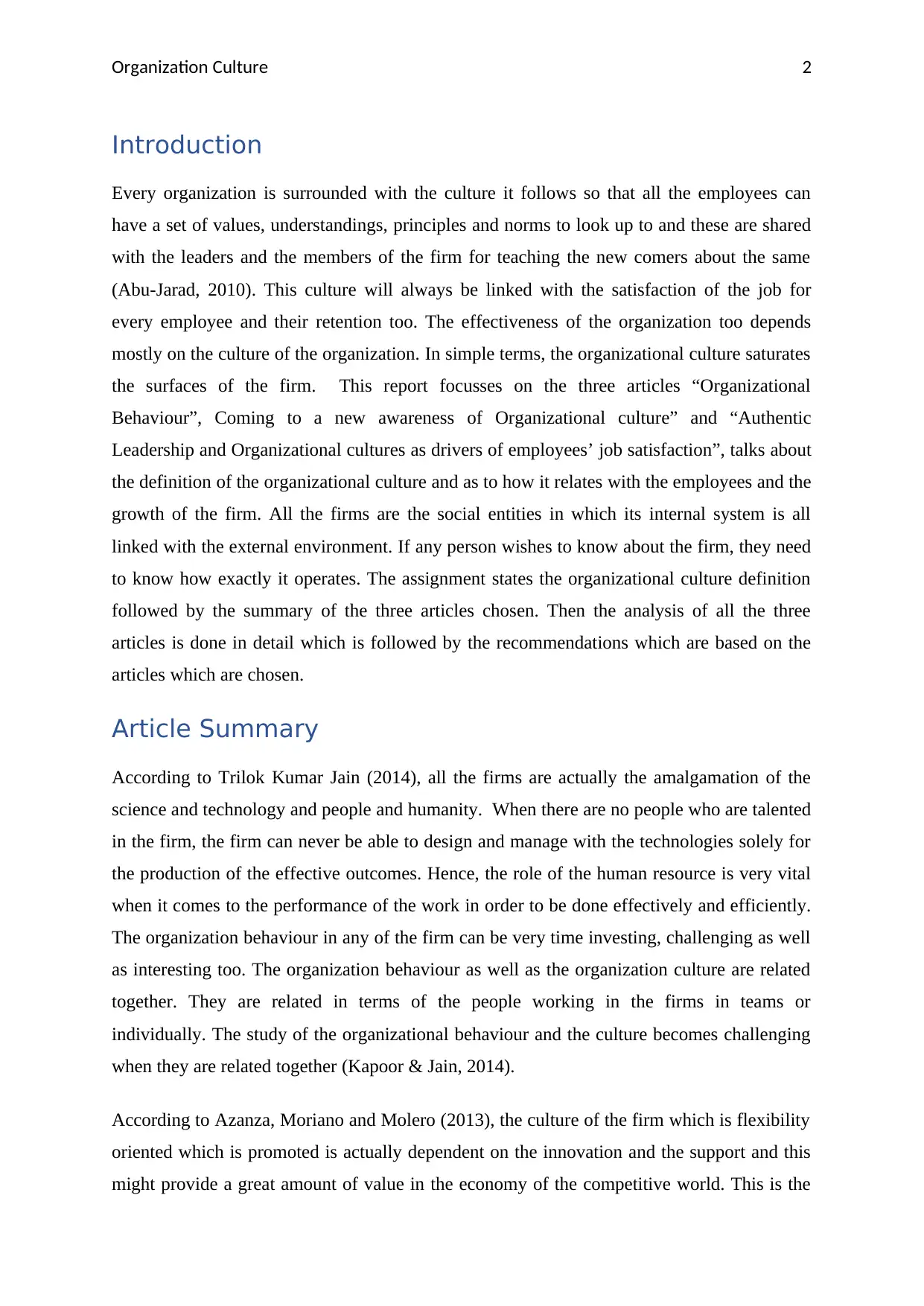
Organization Culture
Introduction
Every organization is surrounded with the culture it follows so that all the employees can
have a set of values, understandings, principles and norms to look up to and these are shared
with the leaders and the members of the firm for teaching the new comers about the same
(Abu-Jarad, 2010). This culture will always be linked with the satisfaction of the job for
every employee and their retention too. The effectiveness of the organization too depends
mostly on the culture of the organization. In simple terms, the organizational culture saturates
the surfaces of the firm. This report focusses on the three articles “Organizational
Behaviour”, Coming to a new awareness of Organizational culture” and “Authentic
Leadership and Organizational cultures as drivers of employees’ job satisfaction”, talks about
the definition of the organizational culture and as to how it relates with the employees and the
growth of the firm. All the firms are the social entities in which its internal system is all
linked with the external environment. If any person wishes to know about the firm, they need
to know how exactly it operates. The assignment states the organizational culture definition
followed by the summary of the three articles chosen. Then the analysis of all the three
articles is done in detail which is followed by the recommendations which are based on the
articles which are chosen.
Article Summary
According to Trilok Kumar Jain (2014), all the firms are actually the amalgamation of the
science and technology and people and humanity. When there are no people who are talented
in the firm, the firm can never be able to design and manage with the technologies solely for
the production of the effective outcomes. Hence, the role of the human resource is very vital
when it comes to the performance of the work in order to be done effectively and efficiently.
The organization behaviour in any of the firm can be very time investing, challenging as well
as interesting too. The organization behaviour as well as the organization culture are related
together. They are related in terms of the people working in the firms in teams or
individually. The study of the organizational behaviour and the culture becomes challenging
when they are related together (Kapoor & Jain, 2014).
According to Azanza, Moriano and Molero (2013), the culture of the firm which is flexibility
oriented which is promoted is actually dependent on the innovation and the support and this
might provide a great amount of value in the economy of the competitive world. This is the
2
Introduction
Every organization is surrounded with the culture it follows so that all the employees can
have a set of values, understandings, principles and norms to look up to and these are shared
with the leaders and the members of the firm for teaching the new comers about the same
(Abu-Jarad, 2010). This culture will always be linked with the satisfaction of the job for
every employee and their retention too. The effectiveness of the organization too depends
mostly on the culture of the organization. In simple terms, the organizational culture saturates
the surfaces of the firm. This report focusses on the three articles “Organizational
Behaviour”, Coming to a new awareness of Organizational culture” and “Authentic
Leadership and Organizational cultures as drivers of employees’ job satisfaction”, talks about
the definition of the organizational culture and as to how it relates with the employees and the
growth of the firm. All the firms are the social entities in which its internal system is all
linked with the external environment. If any person wishes to know about the firm, they need
to know how exactly it operates. The assignment states the organizational culture definition
followed by the summary of the three articles chosen. Then the analysis of all the three
articles is done in detail which is followed by the recommendations which are based on the
articles which are chosen.
Article Summary
According to Trilok Kumar Jain (2014), all the firms are actually the amalgamation of the
science and technology and people and humanity. When there are no people who are talented
in the firm, the firm can never be able to design and manage with the technologies solely for
the production of the effective outcomes. Hence, the role of the human resource is very vital
when it comes to the performance of the work in order to be done effectively and efficiently.
The organization behaviour in any of the firm can be very time investing, challenging as well
as interesting too. The organization behaviour as well as the organization culture are related
together. They are related in terms of the people working in the firms in teams or
individually. The study of the organizational behaviour and the culture becomes challenging
when they are related together (Kapoor & Jain, 2014).
According to Azanza, Moriano and Molero (2013), the culture of the firm which is flexibility
oriented which is promoted is actually dependent on the innovation and the support and this
might provide a great amount of value in the economy of the competitive world. This is the
2
⊘ This is a preview!⊘
Do you want full access?
Subscribe today to unlock all pages.

Trusted by 1+ million students worldwide
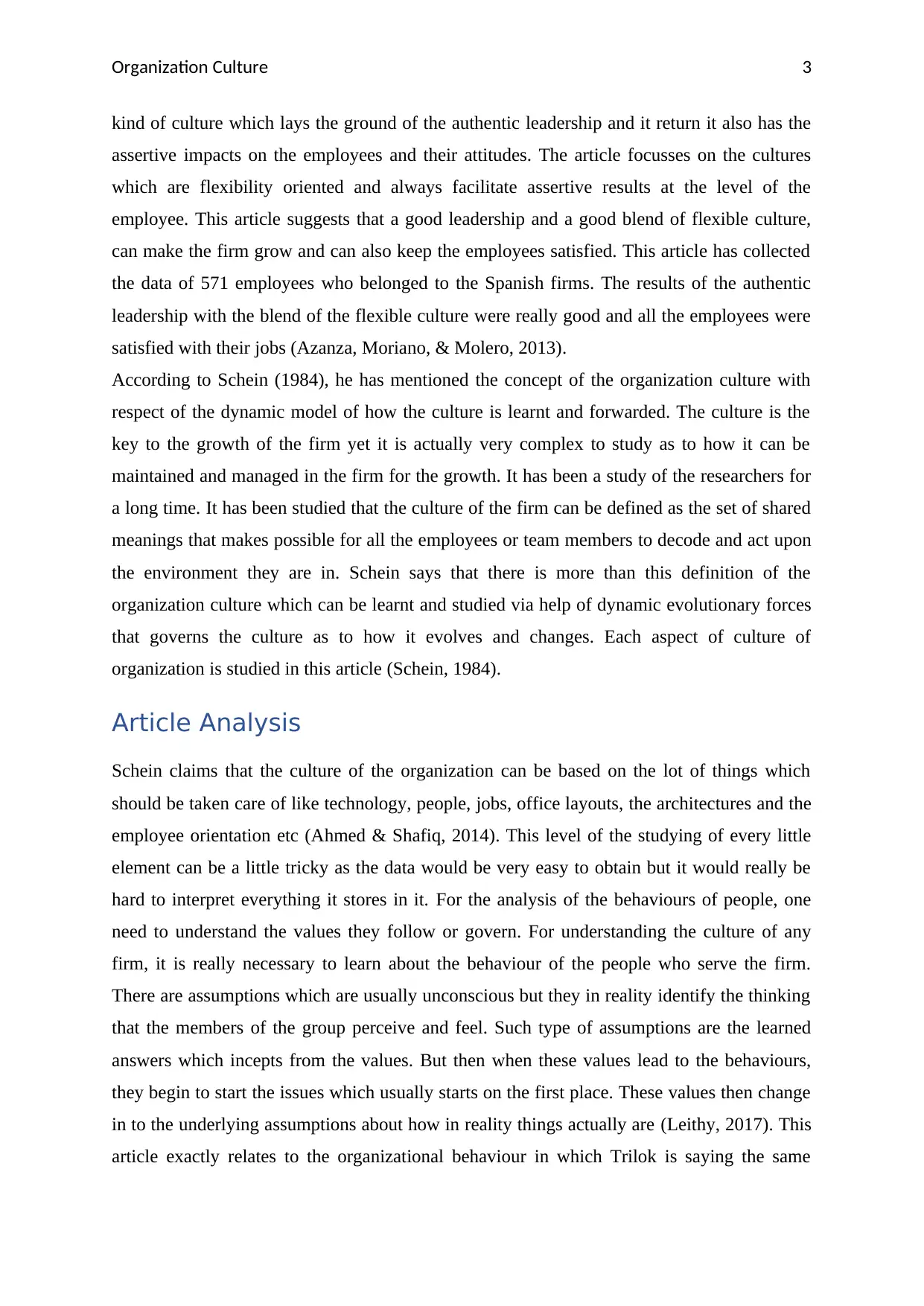
Organization Culture
kind of culture which lays the ground of the authentic leadership and it return it also has the
assertive impacts on the employees and their attitudes. The article focusses on the cultures
which are flexibility oriented and always facilitate assertive results at the level of the
employee. This article suggests that a good leadership and a good blend of flexible culture,
can make the firm grow and can also keep the employees satisfied. This article has collected
the data of 571 employees who belonged to the Spanish firms. The results of the authentic
leadership with the blend of the flexible culture were really good and all the employees were
satisfied with their jobs (Azanza, Moriano, & Molero, 2013).
According to Schein (1984), he has mentioned the concept of the organization culture with
respect of the dynamic model of how the culture is learnt and forwarded. The culture is the
key to the growth of the firm yet it is actually very complex to study as to how it can be
maintained and managed in the firm for the growth. It has been a study of the researchers for
a long time. It has been studied that the culture of the firm can be defined as the set of shared
meanings that makes possible for all the employees or team members to decode and act upon
the environment they are in. Schein says that there is more than this definition of the
organization culture which can be learnt and studied via help of dynamic evolutionary forces
that governs the culture as to how it evolves and changes. Each aspect of culture of
organization is studied in this article (Schein, 1984).
Article Analysis
Schein claims that the culture of the organization can be based on the lot of things which
should be taken care of like technology, people, jobs, office layouts, the architectures and the
employee orientation etc (Ahmed & Shafiq, 2014). This level of the studying of every little
element can be a little tricky as the data would be very easy to obtain but it would really be
hard to interpret everything it stores in it. For the analysis of the behaviours of people, one
need to understand the values they follow or govern. For understanding the culture of any
firm, it is really necessary to learn about the behaviour of the people who serve the firm.
There are assumptions which are usually unconscious but they in reality identify the thinking
that the members of the group perceive and feel. Such type of assumptions are the learned
answers which incepts from the values. But then when these values lead to the behaviours,
they begin to start the issues which usually starts on the first place. These values then change
in to the underlying assumptions about how in reality things actually are (Leithy, 2017). This
article exactly relates to the organizational behaviour in which Trilok is saying the same
3
kind of culture which lays the ground of the authentic leadership and it return it also has the
assertive impacts on the employees and their attitudes. The article focusses on the cultures
which are flexibility oriented and always facilitate assertive results at the level of the
employee. This article suggests that a good leadership and a good blend of flexible culture,
can make the firm grow and can also keep the employees satisfied. This article has collected
the data of 571 employees who belonged to the Spanish firms. The results of the authentic
leadership with the blend of the flexible culture were really good and all the employees were
satisfied with their jobs (Azanza, Moriano, & Molero, 2013).
According to Schein (1984), he has mentioned the concept of the organization culture with
respect of the dynamic model of how the culture is learnt and forwarded. The culture is the
key to the growth of the firm yet it is actually very complex to study as to how it can be
maintained and managed in the firm for the growth. It has been a study of the researchers for
a long time. It has been studied that the culture of the firm can be defined as the set of shared
meanings that makes possible for all the employees or team members to decode and act upon
the environment they are in. Schein says that there is more than this definition of the
organization culture which can be learnt and studied via help of dynamic evolutionary forces
that governs the culture as to how it evolves and changes. Each aspect of culture of
organization is studied in this article (Schein, 1984).
Article Analysis
Schein claims that the culture of the organization can be based on the lot of things which
should be taken care of like technology, people, jobs, office layouts, the architectures and the
employee orientation etc (Ahmed & Shafiq, 2014). This level of the studying of every little
element can be a little tricky as the data would be very easy to obtain but it would really be
hard to interpret everything it stores in it. For the analysis of the behaviours of people, one
need to understand the values they follow or govern. For understanding the culture of any
firm, it is really necessary to learn about the behaviour of the people who serve the firm.
There are assumptions which are usually unconscious but they in reality identify the thinking
that the members of the group perceive and feel. Such type of assumptions are the learned
answers which incepts from the values. But then when these values lead to the behaviours,
they begin to start the issues which usually starts on the first place. These values then change
in to the underlying assumptions about how in reality things actually are (Leithy, 2017). This
article exactly relates to the organizational behaviour in which Trilok is saying the same
3
Paraphrase This Document
Need a fresh take? Get an instant paraphrase of this document with our AI Paraphraser
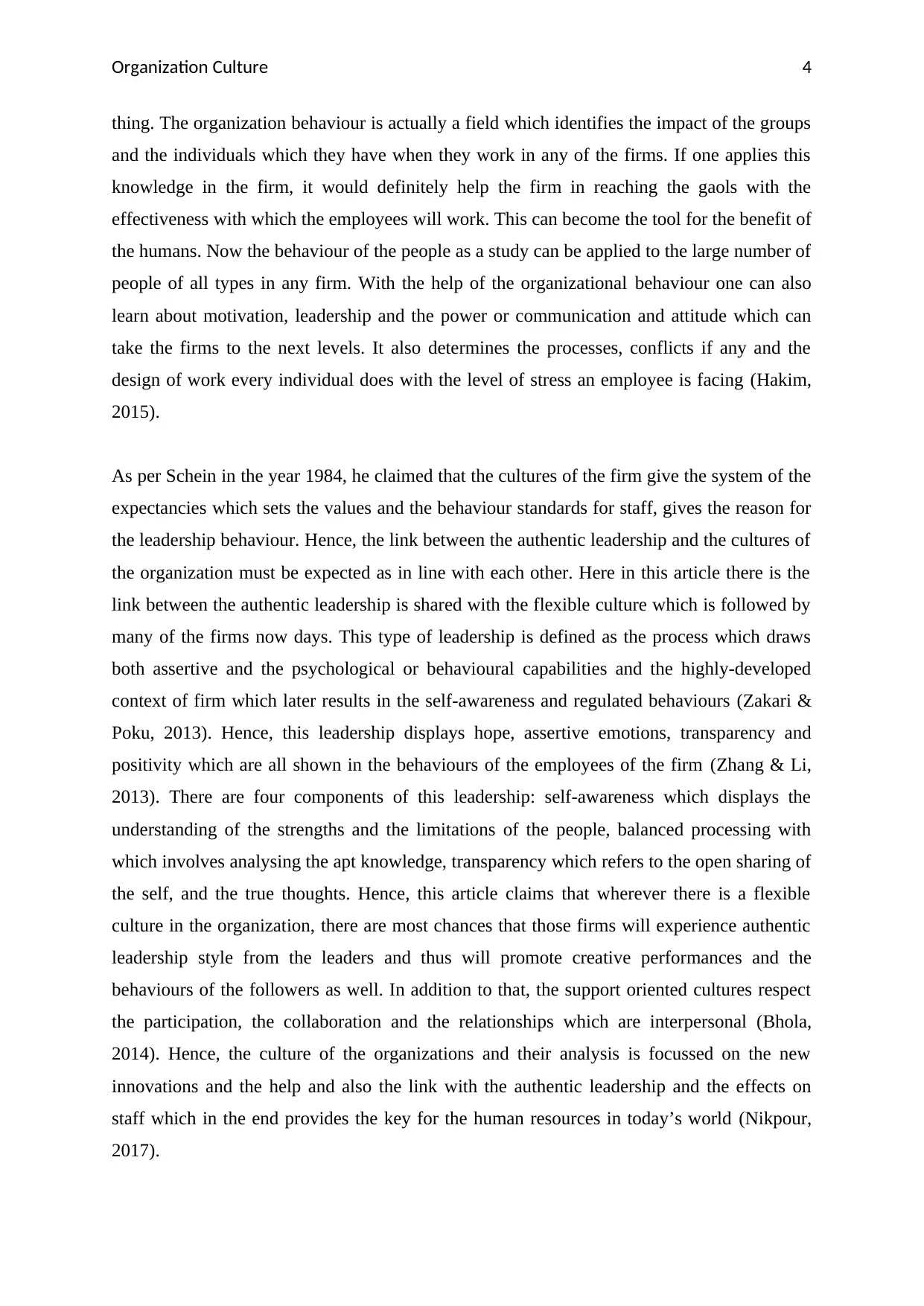
Organization Culture
thing. The organization behaviour is actually a field which identifies the impact of the groups
and the individuals which they have when they work in any of the firms. If one applies this
knowledge in the firm, it would definitely help the firm in reaching the gaols with the
effectiveness with which the employees will work. This can become the tool for the benefit of
the humans. Now the behaviour of the people as a study can be applied to the large number of
people of all types in any firm. With the help of the organizational behaviour one can also
learn about motivation, leadership and the power or communication and attitude which can
take the firms to the next levels. It also determines the processes, conflicts if any and the
design of work every individual does with the level of stress an employee is facing (Hakim,
2015).
As per Schein in the year 1984, he claimed that the cultures of the firm give the system of the
expectancies which sets the values and the behaviour standards for staff, gives the reason for
the leadership behaviour. Hence, the link between the authentic leadership and the cultures of
the organization must be expected as in line with each other. Here in this article there is the
link between the authentic leadership is shared with the flexible culture which is followed by
many of the firms now days. This type of leadership is defined as the process which draws
both assertive and the psychological or behavioural capabilities and the highly-developed
context of firm which later results in the self-awareness and regulated behaviours (Zakari &
Poku, 2013). Hence, this leadership displays hope, assertive emotions, transparency and
positivity which are all shown in the behaviours of the employees of the firm (Zhang & Li,
2013). There are four components of this leadership: self-awareness which displays the
understanding of the strengths and the limitations of the people, balanced processing with
which involves analysing the apt knowledge, transparency which refers to the open sharing of
the self, and the true thoughts. Hence, this article claims that wherever there is a flexible
culture in the organization, there are most chances that those firms will experience authentic
leadership style from the leaders and thus will promote creative performances and the
behaviours of the followers as well. In addition to that, the support oriented cultures respect
the participation, the collaboration and the relationships which are interpersonal (Bhola,
2014). Hence, the culture of the organizations and their analysis is focussed on the new
innovations and the help and also the link with the authentic leadership and the effects on
staff which in the end provides the key for the human resources in today’s world (Nikpour,
2017).
4
thing. The organization behaviour is actually a field which identifies the impact of the groups
and the individuals which they have when they work in any of the firms. If one applies this
knowledge in the firm, it would definitely help the firm in reaching the gaols with the
effectiveness with which the employees will work. This can become the tool for the benefit of
the humans. Now the behaviour of the people as a study can be applied to the large number of
people of all types in any firm. With the help of the organizational behaviour one can also
learn about motivation, leadership and the power or communication and attitude which can
take the firms to the next levels. It also determines the processes, conflicts if any and the
design of work every individual does with the level of stress an employee is facing (Hakim,
2015).
As per Schein in the year 1984, he claimed that the cultures of the firm give the system of the
expectancies which sets the values and the behaviour standards for staff, gives the reason for
the leadership behaviour. Hence, the link between the authentic leadership and the cultures of
the organization must be expected as in line with each other. Here in this article there is the
link between the authentic leadership is shared with the flexible culture which is followed by
many of the firms now days. This type of leadership is defined as the process which draws
both assertive and the psychological or behavioural capabilities and the highly-developed
context of firm which later results in the self-awareness and regulated behaviours (Zakari &
Poku, 2013). Hence, this leadership displays hope, assertive emotions, transparency and
positivity which are all shown in the behaviours of the employees of the firm (Zhang & Li,
2013). There are four components of this leadership: self-awareness which displays the
understanding of the strengths and the limitations of the people, balanced processing with
which involves analysing the apt knowledge, transparency which refers to the open sharing of
the self, and the true thoughts. Hence, this article claims that wherever there is a flexible
culture in the organization, there are most chances that those firms will experience authentic
leadership style from the leaders and thus will promote creative performances and the
behaviours of the followers as well. In addition to that, the support oriented cultures respect
the participation, the collaboration and the relationships which are interpersonal (Bhola,
2014). Hence, the culture of the organizations and their analysis is focussed on the new
innovations and the help and also the link with the authentic leadership and the effects on
staff which in the end provides the key for the human resources in today’s world (Nikpour,
2017).
4
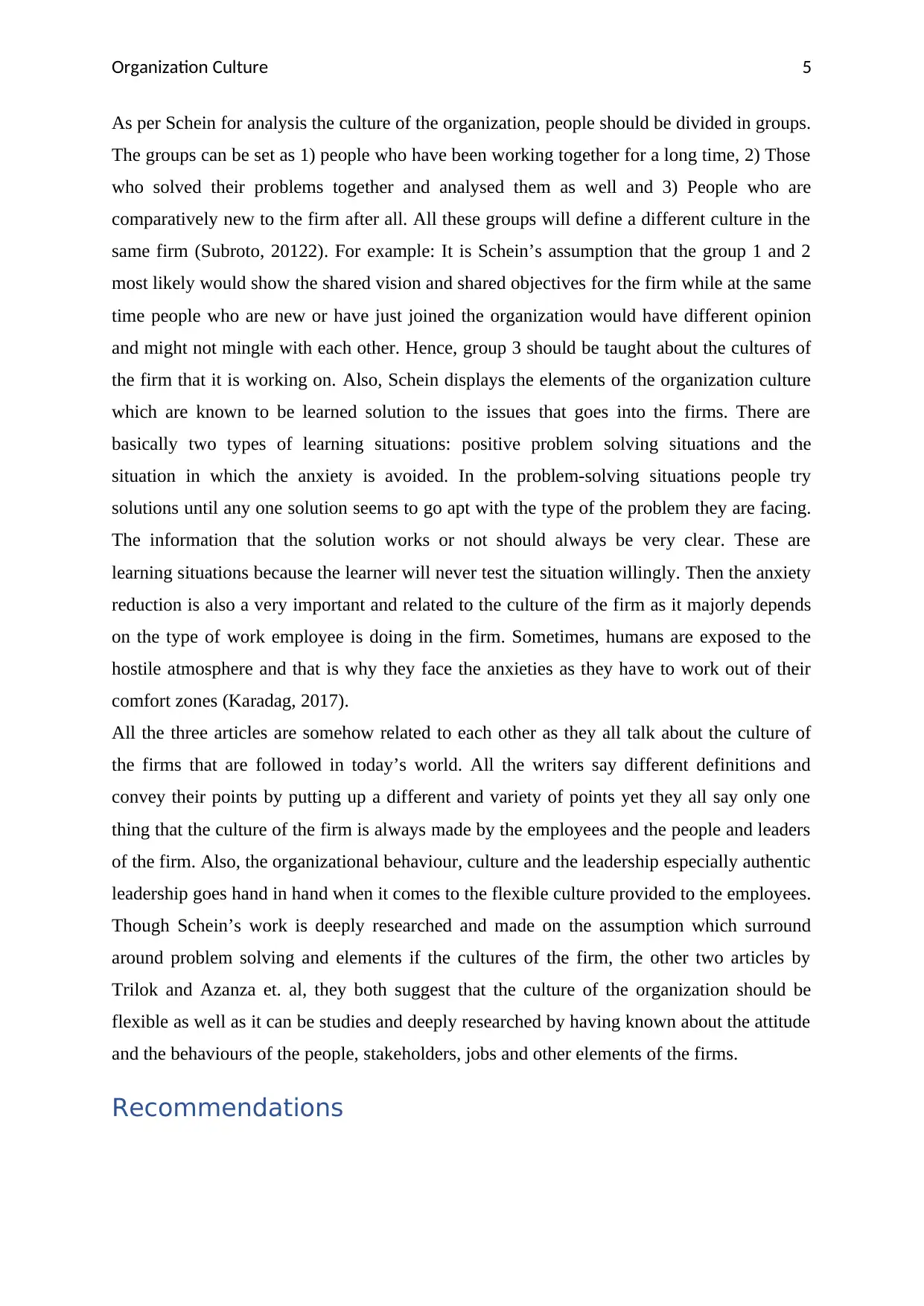
Organization Culture
As per Schein for analysis the culture of the organization, people should be divided in groups.
The groups can be set as 1) people who have been working together for a long time, 2) Those
who solved their problems together and analysed them as well and 3) People who are
comparatively new to the firm after all. All these groups will define a different culture in the
same firm (Subroto, 20122). For example: It is Schein’s assumption that the group 1 and 2
most likely would show the shared vision and shared objectives for the firm while at the same
time people who are new or have just joined the organization would have different opinion
and might not mingle with each other. Hence, group 3 should be taught about the cultures of
the firm that it is working on. Also, Schein displays the elements of the organization culture
which are known to be learned solution to the issues that goes into the firms. There are
basically two types of learning situations: positive problem solving situations and the
situation in which the anxiety is avoided. In the problem-solving situations people try
solutions until any one solution seems to go apt with the type of the problem they are facing.
The information that the solution works or not should always be very clear. These are
learning situations because the learner will never test the situation willingly. Then the anxiety
reduction is also a very important and related to the culture of the firm as it majorly depends
on the type of work employee is doing in the firm. Sometimes, humans are exposed to the
hostile atmosphere and that is why they face the anxieties as they have to work out of their
comfort zones (Karadag, 2017).
All the three articles are somehow related to each other as they all talk about the culture of
the firms that are followed in today’s world. All the writers say different definitions and
convey their points by putting up a different and variety of points yet they all say only one
thing that the culture of the firm is always made by the employees and the people and leaders
of the firm. Also, the organizational behaviour, culture and the leadership especially authentic
leadership goes hand in hand when it comes to the flexible culture provided to the employees.
Though Schein’s work is deeply researched and made on the assumption which surround
around problem solving and elements if the cultures of the firm, the other two articles by
Trilok and Azanza et. al, they both suggest that the culture of the organization should be
flexible as well as it can be studies and deeply researched by having known about the attitude
and the behaviours of the people, stakeholders, jobs and other elements of the firms.
Recommendations
5
As per Schein for analysis the culture of the organization, people should be divided in groups.
The groups can be set as 1) people who have been working together for a long time, 2) Those
who solved their problems together and analysed them as well and 3) People who are
comparatively new to the firm after all. All these groups will define a different culture in the
same firm (Subroto, 20122). For example: It is Schein’s assumption that the group 1 and 2
most likely would show the shared vision and shared objectives for the firm while at the same
time people who are new or have just joined the organization would have different opinion
and might not mingle with each other. Hence, group 3 should be taught about the cultures of
the firm that it is working on. Also, Schein displays the elements of the organization culture
which are known to be learned solution to the issues that goes into the firms. There are
basically two types of learning situations: positive problem solving situations and the
situation in which the anxiety is avoided. In the problem-solving situations people try
solutions until any one solution seems to go apt with the type of the problem they are facing.
The information that the solution works or not should always be very clear. These are
learning situations because the learner will never test the situation willingly. Then the anxiety
reduction is also a very important and related to the culture of the firm as it majorly depends
on the type of work employee is doing in the firm. Sometimes, humans are exposed to the
hostile atmosphere and that is why they face the anxieties as they have to work out of their
comfort zones (Karadag, 2017).
All the three articles are somehow related to each other as they all talk about the culture of
the firms that are followed in today’s world. All the writers say different definitions and
convey their points by putting up a different and variety of points yet they all say only one
thing that the culture of the firm is always made by the employees and the people and leaders
of the firm. Also, the organizational behaviour, culture and the leadership especially authentic
leadership goes hand in hand when it comes to the flexible culture provided to the employees.
Though Schein’s work is deeply researched and made on the assumption which surround
around problem solving and elements if the cultures of the firm, the other two articles by
Trilok and Azanza et. al, they both suggest that the culture of the organization should be
flexible as well as it can be studies and deeply researched by having known about the attitude
and the behaviours of the people, stakeholders, jobs and other elements of the firms.
Recommendations
5
⊘ This is a preview!⊘
Do you want full access?
Subscribe today to unlock all pages.

Trusted by 1+ million students worldwide
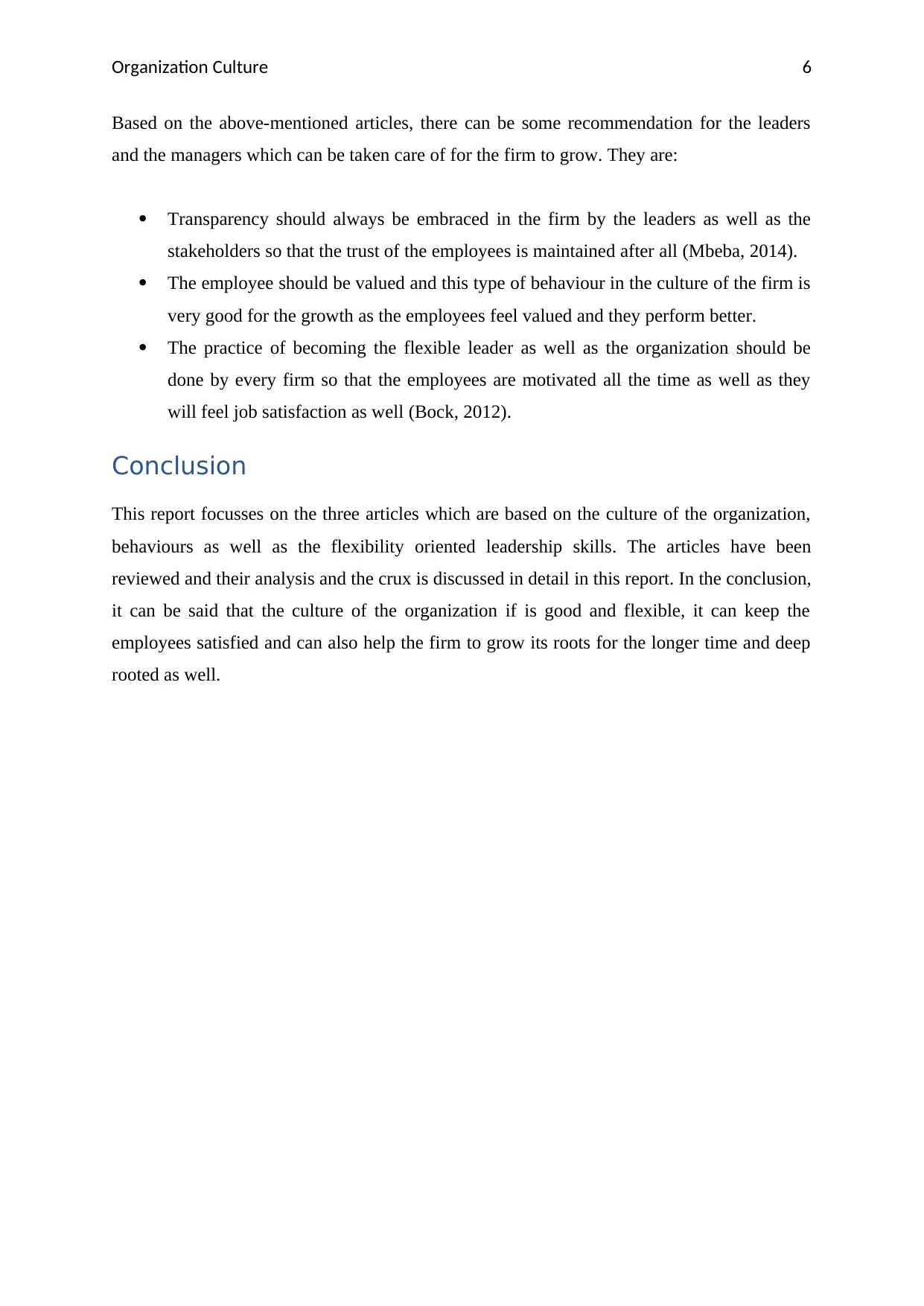
Organization Culture
Based on the above-mentioned articles, there can be some recommendation for the leaders
and the managers which can be taken care of for the firm to grow. They are:
Transparency should always be embraced in the firm by the leaders as well as the
stakeholders so that the trust of the employees is maintained after all (Mbeba, 2014).
The employee should be valued and this type of behaviour in the culture of the firm is
very good for the growth as the employees feel valued and they perform better.
The practice of becoming the flexible leader as well as the organization should be
done by every firm so that the employees are motivated all the time as well as they
will feel job satisfaction as well (Bock, 2012).
Conclusion
This report focusses on the three articles which are based on the culture of the organization,
behaviours as well as the flexibility oriented leadership skills. The articles have been
reviewed and their analysis and the crux is discussed in detail in this report. In the conclusion,
it can be said that the culture of the organization if is good and flexible, it can keep the
employees satisfied and can also help the firm to grow its roots for the longer time and deep
rooted as well.
6
Based on the above-mentioned articles, there can be some recommendation for the leaders
and the managers which can be taken care of for the firm to grow. They are:
Transparency should always be embraced in the firm by the leaders as well as the
stakeholders so that the trust of the employees is maintained after all (Mbeba, 2014).
The employee should be valued and this type of behaviour in the culture of the firm is
very good for the growth as the employees feel valued and they perform better.
The practice of becoming the flexible leader as well as the organization should be
done by every firm so that the employees are motivated all the time as well as they
will feel job satisfaction as well (Bock, 2012).
Conclusion
This report focusses on the three articles which are based on the culture of the organization,
behaviours as well as the flexibility oriented leadership skills. The articles have been
reviewed and their analysis and the crux is discussed in detail in this report. In the conclusion,
it can be said that the culture of the organization if is good and flexible, it can keep the
employees satisfied and can also help the firm to grow its roots for the longer time and deep
rooted as well.
6
Paraphrase This Document
Need a fresh take? Get an instant paraphrase of this document with our AI Paraphraser
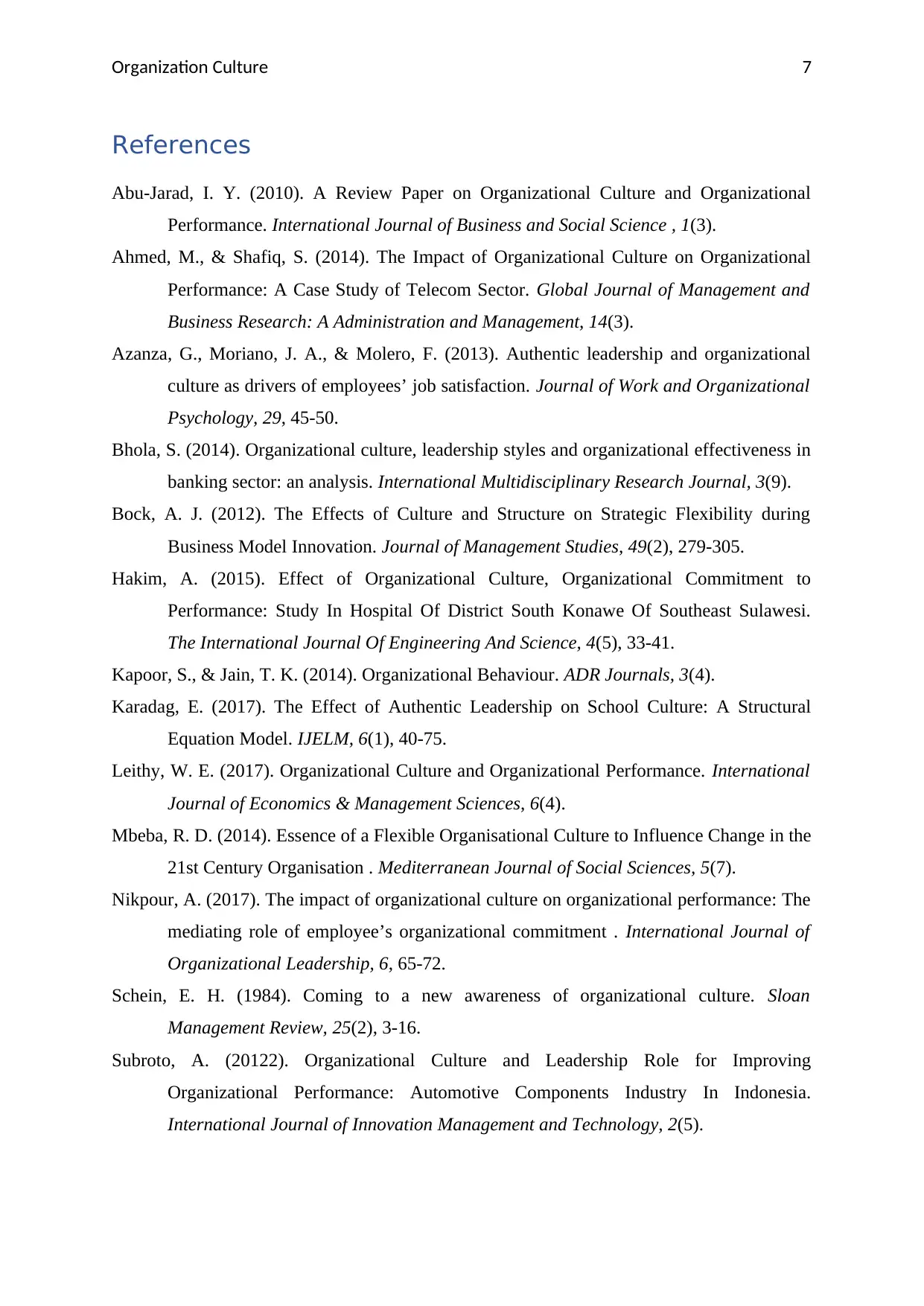
Organization Culture
References
Abu-Jarad, I. Y. (2010). A Review Paper on Organizational Culture and Organizational
Performance. International Journal of Business and Social Science , 1(3).
Ahmed, M., & Shafiq, S. (2014). The Impact of Organizational Culture on Organizational
Performance: A Case Study of Telecom Sector. Global Journal of Management and
Business Research: A Administration and Management, 14(3).
Azanza, G., Moriano, J. A., & Molero, F. (2013). Authentic leadership and organizational
culture as drivers of employees’ job satisfaction. Journal of Work and Organizational
Psychology, 29, 45-50.
Bhola, S. (2014). Organizational culture, leadership styles and organizational effectiveness in
banking sector: an analysis. International Multidisciplinary Research Journal, 3(9).
Bock, A. J. (2012). The Effects of Culture and Structure on Strategic Flexibility during
Business Model Innovation. Journal of Management Studies, 49(2), 279-305.
Hakim, A. (2015). Effect of Organizational Culture, Organizational Commitment to
Performance: Study In Hospital Of District South Konawe Of Southeast Sulawesi.
The International Journal Of Engineering And Science, 4(5), 33-41.
Kapoor, S., & Jain, T. K. (2014). Organizational Behaviour. ADR Journals, 3(4).
Karadag, E. (2017). The Effect of Authentic Leadership on School Culture: A Structural
Equation Model. IJELM, 6(1), 40-75.
Leithy, W. E. (2017). Organizational Culture and Organizational Performance. International
Journal of Economics & Management Sciences, 6(4).
Mbeba, R. D. (2014). Essence of a Flexible Organisational Culture to Influence Change in the
21st Century Organisation . Mediterranean Journal of Social Sciences, 5(7).
Nikpour, A. (2017). The impact of organizational culture on organizational performance: The
mediating role of employee’s organizational commitment . International Journal of
Organizational Leadership, 6, 65-72.
Schein, E. H. (1984). Coming to a new awareness of organizational culture. Sloan
Management Review, 25(2), 3-16.
Subroto, A. (20122). Organizational Culture and Leadership Role for Improving
Organizational Performance: Automotive Components Industry In Indonesia.
International Journal of Innovation Management and Technology, 2(5).
7
References
Abu-Jarad, I. Y. (2010). A Review Paper on Organizational Culture and Organizational
Performance. International Journal of Business and Social Science , 1(3).
Ahmed, M., & Shafiq, S. (2014). The Impact of Organizational Culture on Organizational
Performance: A Case Study of Telecom Sector. Global Journal of Management and
Business Research: A Administration and Management, 14(3).
Azanza, G., Moriano, J. A., & Molero, F. (2013). Authentic leadership and organizational
culture as drivers of employees’ job satisfaction. Journal of Work and Organizational
Psychology, 29, 45-50.
Bhola, S. (2014). Organizational culture, leadership styles and organizational effectiveness in
banking sector: an analysis. International Multidisciplinary Research Journal, 3(9).
Bock, A. J. (2012). The Effects of Culture and Structure on Strategic Flexibility during
Business Model Innovation. Journal of Management Studies, 49(2), 279-305.
Hakim, A. (2015). Effect of Organizational Culture, Organizational Commitment to
Performance: Study In Hospital Of District South Konawe Of Southeast Sulawesi.
The International Journal Of Engineering And Science, 4(5), 33-41.
Kapoor, S., & Jain, T. K. (2014). Organizational Behaviour. ADR Journals, 3(4).
Karadag, E. (2017). The Effect of Authentic Leadership on School Culture: A Structural
Equation Model. IJELM, 6(1), 40-75.
Leithy, W. E. (2017). Organizational Culture and Organizational Performance. International
Journal of Economics & Management Sciences, 6(4).
Mbeba, R. D. (2014). Essence of a Flexible Organisational Culture to Influence Change in the
21st Century Organisation . Mediterranean Journal of Social Sciences, 5(7).
Nikpour, A. (2017). The impact of organizational culture on organizational performance: The
mediating role of employee’s organizational commitment . International Journal of
Organizational Leadership, 6, 65-72.
Schein, E. H. (1984). Coming to a new awareness of organizational culture. Sloan
Management Review, 25(2), 3-16.
Subroto, A. (20122). Organizational Culture and Leadership Role for Improving
Organizational Performance: Automotive Components Industry In Indonesia.
International Journal of Innovation Management and Technology, 2(5).
7
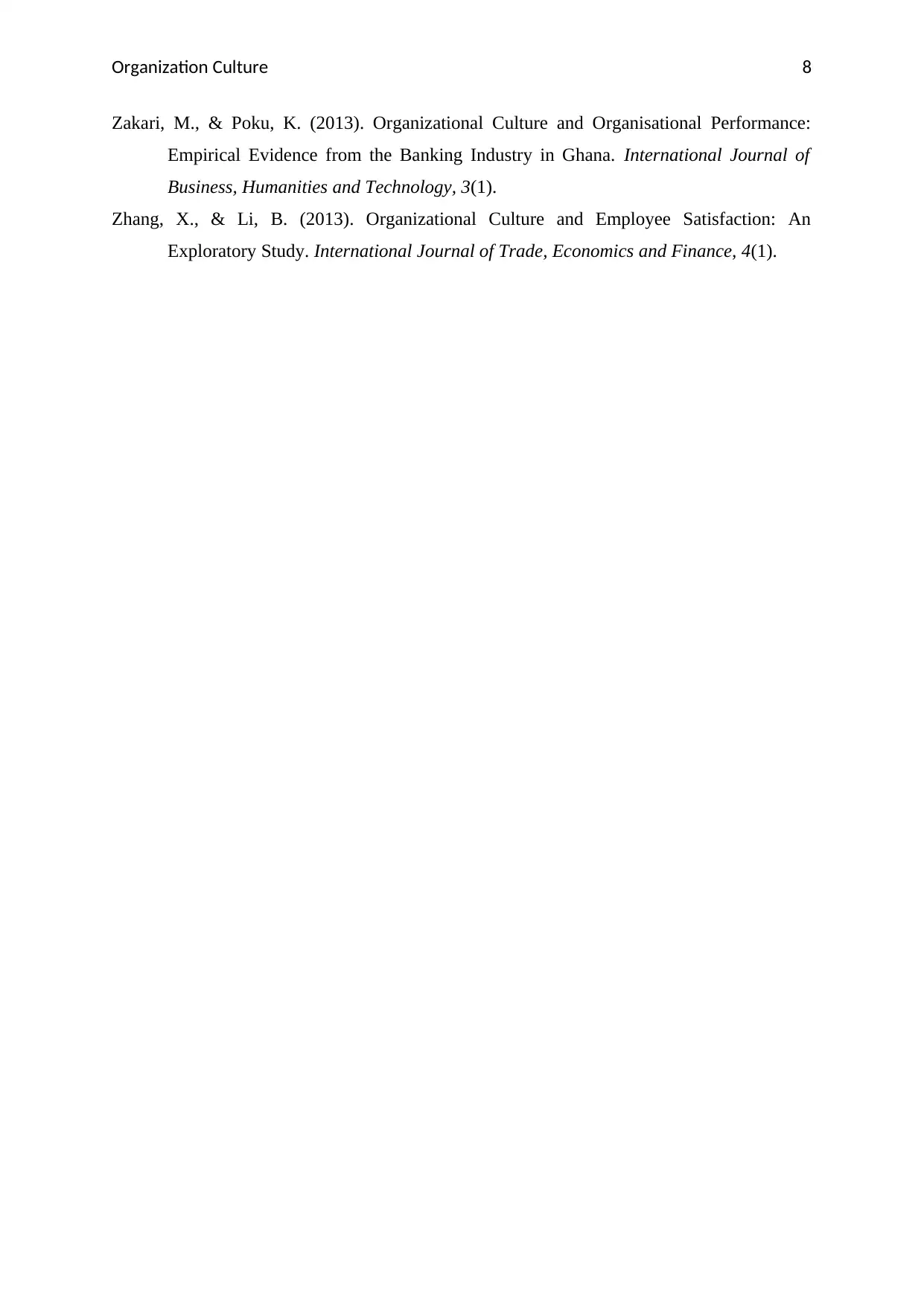
Organization Culture
Zakari, M., & Poku, K. (2013). Organizational Culture and Organisational Performance:
Empirical Evidence from the Banking Industry in Ghana. International Journal of
Business, Humanities and Technology, 3(1).
Zhang, X., & Li, B. (2013). Organizational Culture and Employee Satisfaction: An
Exploratory Study. International Journal of Trade, Economics and Finance, 4(1).
8
Zakari, M., & Poku, K. (2013). Organizational Culture and Organisational Performance:
Empirical Evidence from the Banking Industry in Ghana. International Journal of
Business, Humanities and Technology, 3(1).
Zhang, X., & Li, B. (2013). Organizational Culture and Employee Satisfaction: An
Exploratory Study. International Journal of Trade, Economics and Finance, 4(1).
8
⊘ This is a preview!⊘
Do you want full access?
Subscribe today to unlock all pages.

Trusted by 1+ million students worldwide
1 out of 9
Related Documents
Your All-in-One AI-Powered Toolkit for Academic Success.
+13062052269
info@desklib.com
Available 24*7 on WhatsApp / Email
![[object Object]](/_next/static/media/star-bottom.7253800d.svg)
Unlock your academic potential
Copyright © 2020–2025 A2Z Services. All Rights Reserved. Developed and managed by ZUCOL.





